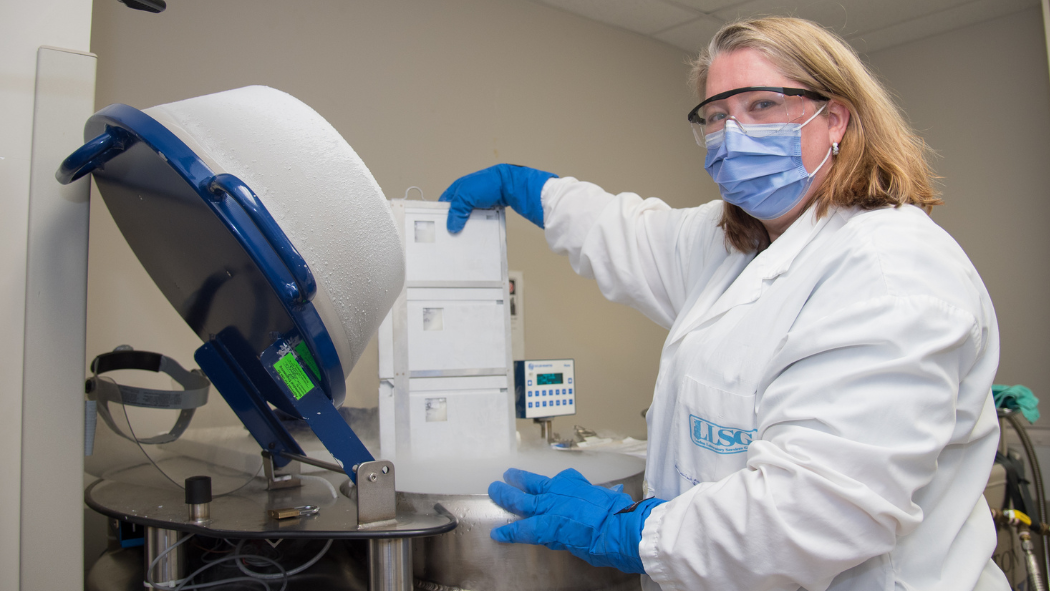
April 13, 2023
Within the Transfusion Medicine Laboratory at London Health Sciences Centre (LHSC) is the Stem Cell Processing Laboratory for the Blood and Marrow Transplant Program. This specialized section of the lab, processes stem cells collected from patients themselves, (autologous) or related donors (allogeneic) and then gives them back into the patient’s blood stream after they have undergone conditioning treatment, including chemotherapy. The team of six specialized medical laboratory technologists works in conjunction with other labs and departments at LHSC to ensure the collected cells are healthy and abundant enough to be frozen and prepared for the patient when needed.
Stem cell transplant and cellular therapy is a new and growing field. Oversight is provided by multiple organizations including Health Canada, Foundation for the Accreditation of Cellular Therapy (FACT) and Accreditation Canada Diagnostic. The processing lab has many regulations, policies and procedures that the technologists must follow to ensure product and patient safety.
The processing technologists in the lab play a crucial role in the stem cell products that are being used to help patients, explains Jeff Kinney, manager of the Transfusion Medicine Laboratory including the cell processing section.
What is stem cell transplant?
Stem cells are immature cells that can develop into all types of blood cells including white blood cells, red blood cells, platelets and more. Most stem cells are found in the bone marrow which is the soft spongy area inside the bones. By taking a special medication, the stem cells are “mobilized” to move from the bone marrow into the blood stream (or peripheral blood). These mobilized cells are called peripheral blood stem cells. By moving the stem cells to the blood stream, they can be more easily collected. The cells are collected in the apheresis department at LHSC.
At LHSC, this type of treatment is provided primarily to patients with blood cancers including multiple myeloma, leukemia, and lymphoma. By transplanting the stem cells back into the patient, the cells are able to regenerate and help patients recover.
What happens to the cells after they’re collected?
Following the collection of the stem cells, testing begins to determine how many stem cells have been collected. There is a minimum amount that is required in order to be able to re-infuse them. This work is done by the flow cytometry lab. The next step involves ensuring there is no bacterial contamination of the cells, which is completed by microbiology lab. The technologists in the processing laboratory prepare the cells for freezing (cryopreservation) and storage at temperatures colder than -150 degrees Celsius.
Cryopreserved cells are stored until the patient needs them. Cells are stored on site and are generally used within one to two months. However, they can be stored for up to five years. The cells are taken out of storage, transported to the patient care area, put in warm water to thaw, then given to the patient in a manner similar to a blood transfusion.
Working in the Stem Cell Processing Lab
For Karla Schebesch, a senior medical lab technologist, being able to support patients in their care journey is important. “It’s the knowledge that I’m helping to make a difference,” she says. A member of team LHSC for 22 years, Schebesch decided to expand her knowledge and train in the stem cell processing lab starting in 2012.
Training is provided at LHSC in a manner similar to an apprenticeship where trainees have a minimum number of processing cases to complete. As there are many different procedures and processes, they need to be competent in, the training is on-going and includes competency assessments done on an annual basis.
This area of treatment support is growing. Schebesch has seen the number of transplants performed at LHSC on an annual basis double from fewer than 50 to over 100 in less than a decade. “We help ensure the best quality products are given and the patient goes home with the best possible outcome whether using autologous or allogeneic (donated) stem cells,” explains Schebesch.
For Schebesch, and her colleagues in all the medical laboratories, technologists are impacting the lives and treatment of patients 24/7. It is important to shine a light on the work done behind the scenes throughout LHSC and celebrate Medical Laboratory Week.